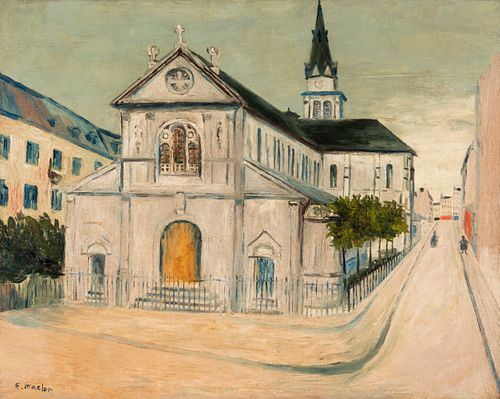ELISÉE MACLET (Lyons-en-Santerre, 1881 - Paris 1962). "Church with characters". Oil on canvas. Signed in the lower left corner.
Lot 55
About Seller
Setdart Auction House
Carrer Aragó 346
Barcelona
Spain
Setdart Subastas was born in 2004 and is currently the first online art auction in Spain with solidity, prestige and reliability guaranteed by our more than 60,000 users. Setdart has a young, dynamic and enterprising team ready to successfully manage the purchase and sale of art works through custom...Read more
Estimate:
$3,000 - $4,000
Absentee vs Live bid
Two ways to bid:
- Leave a max absentee bid and the platform will bid on your behalf up to your maximum bid during the live auction.
- Bid live during the auction and your bids will be submitted real-time to the auctioneer.
Bid Increments
| Price | Bid Increment |
|---|---|
| $0 | $10 |
| $200 | $25 |
| $500 | $50 |
| $1,000 | $100 |
| $3,000 | $200 |
| $5,000 | $500 |
| $10,000 | $1,000 |
| $20,000 | $2,000 |
| $50,000 | $5,000 |
About Auction
By Setdart Auction House
Jun 17, 2021
Set Reminder
2021-06-17 06:15:00
2021-06-17 06:15:00
America/New_York
Bidsquare
Bidsquare : 19th & 20th Century Contemporary Art - Select Lots
https://www.bidsquare.com/auctions/setdart-auction-house/19th-20th-century-contemporary-art---select-lots-7081
Setdart Auction House sofia@setdart.com
Setdart Auction House sofia@setdart.com
- Lot Description
ELISÉE MACLET (Lyons-en-Santerre, 1881 - Paris 1962). "Church with characters". Oil on canvas. Signed in the lower left corner. Work exhibited in the Elisée Maclet retrospective held in Paris in 1960. With label on the back. Measurements: 80.5 x 65 cm; 95 x 79.5 cm (frame). Elisée Maclet represents in this canvas the Versailles road in Louveciennes, a place previously immortalized by great masters such as Camille Pisarro or Claude Monet. On this occasion Maclet gives us a view captured from a high point of view, determined by the diagonal of the road and ultimately by the gardens of Versailles. Royal carriages, families of characters or riders on horseback dot a work defined by an intense and bold palette in which earthy, blue and greenish tones predominate. Elisée Maclet thus demonstrates once again his interest in the most recognizable enclaves of Paris and its surroundings, always captured through the masterful post-impressionist style that characterized him. Élisée Maclet initially developed a "primitivist" style of painting that would earn him a place among the "naïff" painters of the beginning of the century. In 1906, Maclet moved to Paris. There he settled in the Montmartre district and produced most of the landscape and street scenes for which he is best known. Maclet's Parisian scenes were successful, especially after World War I, and he maintained this success for the rest of his career because of the unique sensibility and original techniques he demonstrated in his works. Many of the French writers appreciated his paintings and often wrote about him, including Max Jacob, Sidonie Gabrielle Colette, and Francis Carco. From 1918 to 1919, Maclet painted seascapes in Dieppe, living in a house that Carco lent him. He returned to Montmartre in 1919. In 1920, the art dealer, Dosbourg, bought some of his early Montmartre scenes. He lived in Arles from 1923 to 1928, where he painted many remarkable landscapes expressing his enchantment with nature and Mediterranean culture, some of which are sometimes reminiscent of Matisse. In 1928, Maclet received his first major solo exhibition, held at the Gallerie Barreiro in Paris, where more than 50 of his works were exhibited. At the end of the year, he left mainland France on a painting excursion to the island of Corsica. He then went to Brittany, where he lived and worked in 1929 and 1930. In 1957 the first major retrospective of Maclet's work was held at the Nicolas Poussin Gallery in Paris, and in 1960 the same gallery presented his work in its "20th Century Paintings" exhibition; another major retrospective took place in 1961, at the Thibaut Gallery in New York City. In the period following his international breakthrough, Maclet was the subject of numerous magazine articles and, over time, several public collections in Europe and America acquired examples of his work, including museums in Chicago, Bremen, Geneva, Sweden, Norway and Monte. After his death in 1962, Maclet posthumously received several international tributes, including solo exhibitions in Paris, Germany, and Venezuela, as well as a prominent exhibition at the Vestart Galleries in New York City in 1969. In 2011, the National Gallery of Bermuda mounted a solo exhibition of his work. Currently, his work is represented in a number of important international collections, both public and private, with many of his paintings held by the Musée d'Art Moderne in Paris.
- Shipping Info
-
In-house shipping available. Please inquire at admin@setdart.com.
-
- Buyer's Premium



 EUR
EUR CAD
CAD AUD
AUD GBP
GBP MXN
MXN HKD
HKD CNY
CNY MYR
MYR SEK
SEK SGD
SGD CHF
CHF THB
THB















